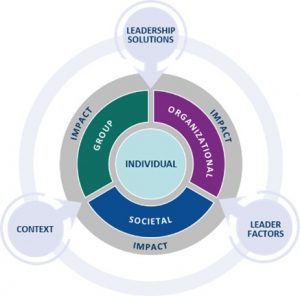By: Sol Bulkin and Ezekiel Welsh
Going through a leadership development program can be like adding tools to your toolbox. In a home improvement project, you might use the same toolbox to upgrade your bedroom or to improve the foundation of the home. When organizations invest in their leader’s development, they hope they can leverage the tools they gain to not only positively impact themselves and their immediate teams, but also the organization.
At the Center for Creative Leadership (CCL), we expect leadership development programs to impact individual leaders, their teams, their organizations, and even sometimes beyond their organizations. These levels of impact can be interrelated. For instance, when multiple teams improve their feedback delivery, it can foster a feedback culture across the organization. However, understanding the extent to which leaders use these tools to create change at the organizational level can be tricky. Are leaders coming away from our programs feeling empowered to have a direct impact on their organization?
To answer this question, we took a deep dive into participant ratings and open-ended comments from our end of program and post-program surveys to see what changes participants intend to and actually make.
Do leaders intend to make changes that impact their organization?
Our end of program results show “yes”! Three key data points lead us to this conclusion:
- When leaders were asked to select 3 possible changes from a list of 10, 52% of 7,982 leaders chose organizational culture change (see figure 1).
- Out of 26,098 leaders, 20,412 (78%) said that they would apply the knowledge and skills they learned to improve their impact on their organization (responses range from “to great extent” or “to a very great extent”)
- When asked about the changes leaders intended to make, 18% commented specifically on impacting the organization (responses to an open-ended question).
Figure 1: Program Outcomes with the Percentage of Leaders Prepared to Change Them, in Descending Order

What kind of organizational impact do leaders say they intend to have?
Through hierarchical text analysis we identified high-level themes and sub-themes from the responses to the question, “In the next three months, what changes will you make as a result of this program?” High-level themes are categorized by what level they will impact (individual, group, or organization) and matched to CCL’s Leadership Development Impact (LDI) framework. The sub-themes are categorized by the specific topics that leaders intended to change.
Figure 2: Leadership Development Impact Framework

After conducting , we found 3,683 explicit mentions of intended organizational. As mentioned above, these statements make up 18% of the comments after removing “no change” or “unsure of change” comments. When we drill down into the sub-themes, the two largest themes for intended organizational change were:
- Direction, Alignment, Commitment (52% of the comments) and,
- Culture Change (10% of the comments)
Direction, Alignment, and Commitment (DAC) is a framework that CCL uses to define leadership as the process of producing direction, alignment and commitment. Leaders intending to increase DAC, as a result of their program experience, points to their willingness to make an impact beyond themselves in service of the success of the organization. Here are some examples of how leaders plan to use DAC to affect their organization:
Figure 3: Direction, Alignment, Commitment (DAC) Anticipated Changes

When looking through the comments, it becomes evident that many leaders plan to use the DAC framework as a guide to connect leaders across different departments and organizational levels to accomplish the goals of their organizations.
Culture Change refers to aligning an organization’s norms, vision, and values. Digging deeper into the organizational culture comments, we found that 10% directly mention culture. Below are examples of leaders’ remarks:
Figure 4: Culture Change Anticipated Changes

When examining these comments, we see that leaders come away from CCL’s programs with specific ideas about how they want to improve the culture at their organization. This can range from wanting to create a better culture of feedback to wanting to integrate diversity, equity, and inclusion (DEI) into the culture. They mention actionable changes that they intend to implement using tools from the program.
What changes did leaders actually implement post-programs?
To understand the impact that occurs when leaders apply what they have learned to their organizations, and to see if it matched up with leaders’ intended impact, we examined results from a survey that is sent to leaders 8 weeks post-program. In this post-program survey, leaders rated the extent to which they’ve improved on the outcomes they reported they would change in the end of program survey. Amongst those who selected they intended to change their organization’s culture, leaders rated a 51% improvement in this area.
The most significant changes made since going through their programs:
- 380 leaders (19%) mentioned having made significant progress at the organizational level.
- DAC and Culture change were once again the two largest sub-themes within the organizational impact high-level theme.
- Out of the 380 responses, 37% were about DAC and 15% were about Culture Change.
These results show that the subset of leaders who complete this post-program survey are still finding concepts from CCL’s programs useful for helping them directly affect their organizations.
Here’s what leaders are saying about the impact they’ve had since attending our leadership programs:
Figure 5: Direction, Alignment, Commitment (DAC) Reported Changes

Figure 6: Culture Change Reported Changes

Overall, leaders appear to be applying many of the changes they intended to make in their organizations. Other data collected from the post program demonstrates that leaders are returning to their workplace with more energy and confidence that they can contribute to organizational goals. Between 74% to 79% of 3,707 leaders report improvements in their impact on their organization’s success (see figure 7 for item breakdown). Renewed energy and confidence may be a contributing factor to their ability to apply what they learned in their organizations.
Figure 7: Percentage of Respondents Reporting Increased Impact on their Organizations
 Conclusion
Conclusion
Leaders who go through CCL’s programs want to create change at various levels, including the organizational level. Change at the organizational level comes in a variety of forms, but from our programs, we see an emphasis in wanting to use the DAC model and to change organizational culture.
Leaders looking to increase DAC at their organizations are essentially trying to make more leadership happen at the collective level. They strive to enable people to work together to more efficiently achieve organizational goals. Culture is the backdrop of any organization. If leaders learn skills to improve themselves and their teams, but the organizational culture does not support leveraging those skills, they may not have the impact they would like. Our findings that a large portion of leaders do intend to have an impact on culture are encouraging, as change at the cultural level provides a crucial environment for change at the individual or team level to occur.
It’s important for organizations to recognize that employees come out of leadership development programs with goals and desires to have a direct impact on their organization. If organizations provide leaders who go through leadership development programs with proper support, they will not only gain tools to better themselves or their teams, but to benefit the whole organization.
Ezekiel Welsh is an evaluation analyst with experience in employee data and leadership development program evaluation. He has served as an evaluation analyst on the Insights & Impact team for a year primarily helping with qualitative analysis and creating client dashboards. While completing his master’s program at San Diego State University he worked on research projects that examined implicit bias at the county level in the United States and how flexible work arraignments are stigmatized in the workplace.

-
-
 Ezekiel Welsh Evaluation Analyst
Ezekiel Welsh Evaluation Analyst



